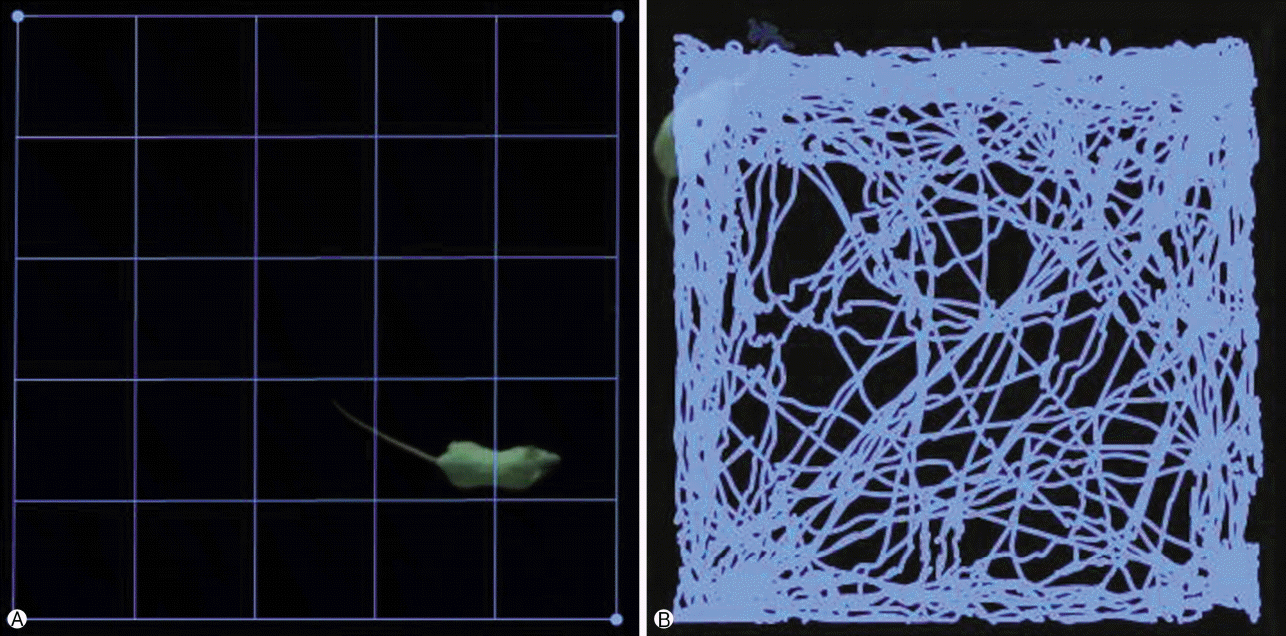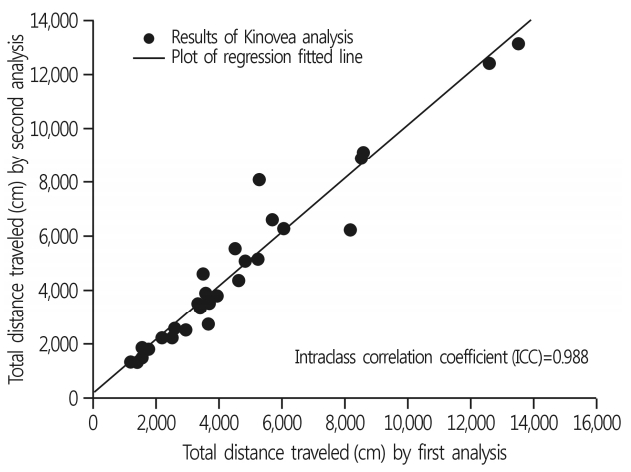1. Tosini G. Locomotor activity in rodents. Methods Mol Biol. 2007; 362:95–101.

2. Gray VC, Hughes RN. Drug-, dose- and sex-dependent effects of chronic fluoxetine, reboxetine and venlafaxine on openfield behavior and spatial memory in rats. Behav Brain Res. 2015; 281:43–54.

3. Roybal K, Theobold D, Graham A, DiNieri JA, Russo SJ, Krishnan V, et al. Mania-like behavior induced by disruption of CLOCK. Proc Natl Acad Sci U S A. 2007; 104:6406–11.
4. Machado DG, Cunha MP, Neis VB, Balen GO, Colla A, Grando J, et al. Fluoxetine reverses depressive-like behaviors and increases hippocampal acetylcholinesterase activity induced by olfactory bulbectomy. Pharmacol Biochem Behav. 2012; 103:220–9.

5. Bondar NP, Lepeshko AA, Reshetnikov VV. Effects of early-life stress on social and anxiety-like behaviors in adult mice: sex-specific effects. Behav Neurol. 2018; 2018:1538931.

6. Niikura K, Ho A, Kreek MJ, Zhang Y. Oxycodone-induced conditioned place preference and sensitization of locomotor activity in adolescent and adult mice. Pharmacol Biochem Behav. 2013; 110:112–6.

7. Walsh RN, Cummins RA. The open-field test: a critical review. Psychol Bull. 1976; 83:482–504.

8. Machado DG, Bettio LE, Cunha MP, Capra JC, Dalmarco JB, Pizzolatti MG, et al. Antidepressant-like effect of the extract of Rosmarinus officinalis in mice: involvement of the monoaminergic system. Prog Neuropsychopharmacol Biol Psychiatry. 2009; 33:642–50.

9. Jung SH, Park JM, Moon E, Chung YI, Lee BD, Lee YM, et al. Delay in the recovery of normal sleep-wake cycle after disruption of the light-dark cycle in mice: a bipolar disorderprone animal model? Psychiatry Investig. 2014; 11:487–91.

10. Zhang JJ, Kong Q. Locomotor activity: a distinctive index in morphine self-administration in rats. PLoS One. 2017; 12:e0174272.

11. Otero L, Zurita M, Aguayo C, Bonilla C, Rodríguez A, Vaquero J. Video-tracking-box linked to smart software as a tool for evaluation of locomotor activity and orientation in brain-injured rats. J Neurosci Methods. 2010; 188:53–7.

12. Kulikov AV, Tikhonova MA, Kulikov VA. Automated measurement of spatial preference in the open field test with transmitted lighting. J Neurosci Methods. 2008; 170:345–51.

13. Guzmán-Valdivia CH, Blanco-Ortega A, Oliver-Salazar MA, Carrera-Escobedo JL. Therapeutic motion analysis of lower limbs using Kinovea. Int J Soft Comput Eng. 2013; 3:359–65.
14. Balsalobre-Fernández C, Tejero-González CM, del Campo-Vecino J, Bavaresco N. The concurrent validity and reliability of a low-cost, high-speed camera-based method for measuring the flight time of vertical jumps. J Strength Cond Res. 2014; 28:528–33.

15. Baude M, Hutin E, Gracies JM. A bidimensional system of facial movement analysis conception and reliability in adults. Biomed Res Int. 2015; 2015:812961.

16. Moral-Muñoz JA, Esteban-Moreno B, Arroyo-Morales M, Cobo MJ, Herrera-Viedma E. agreement between face-to-face and free software video analysis for assessing hamstring flexibility in adolescents. J Strength Cond Res. 2015; 29:2661–5.

17. Padulo J, Vando S, Chamari K, Chaouachi A, Bagno D, Pizzolato F. Validity of the MarkWiiR for kinematic analysis during walking and running gaits. Biol Sport. 2015; 32:53–8.

18. Elwardany SH, El-Sayed WH, Ali MF. Reliability of Kinovea computer program in measuring cervical range of motion in sagittal plane. Open Access Libr J. 2015; 2:e1916.

19. Abd Elrahim RM, Embaby EM, Ali MF, Kamel RM. Interrater and intra-rater reliability of Kinovea software for measurement of shoulder range of motion. Bull Fac Phys Ther. 2016; 21:80–7.

20. Grigg J, Haakonssen E, Rathbone E, Orr R, Keogh JWL. The validity and intra-tester reliability of markerless motion capture to analyse kinematics of the BMX supercross gate start. Sports Biomech. 2017; 1–19.
21. Fleiss JL. The design and analysis of clinical experiments. New York: Wiley;1986.
22. Koo TK, Li MY. A guideline of selecting and reporting intraclass correlation coefficients for reliability research. J Chiropr Med. 2016; 15:155–63.

23. Mukaka MM. Statistics corner: a guide to appropriate use of correlation coefficient in medical research. Malawi Med J. 2012; 24:69–71.
24. Tzschentke TM. Measuring reward with the conditioned place preference (CPP) paradigm: update of the last decade. Addict Biol. 2007; 12:227–462.

25. Thiel KJ, Okun AC, Neisewander JL. Social reward-conditioned place preference: a model revealing an interaction between cocaine and social context rewards in rats. Drug Alcohol Depend. 2008; 96:202–12.






 PDF
PDF ePub
ePub Citation
Citation Print
Print






 XML Download
XML Download